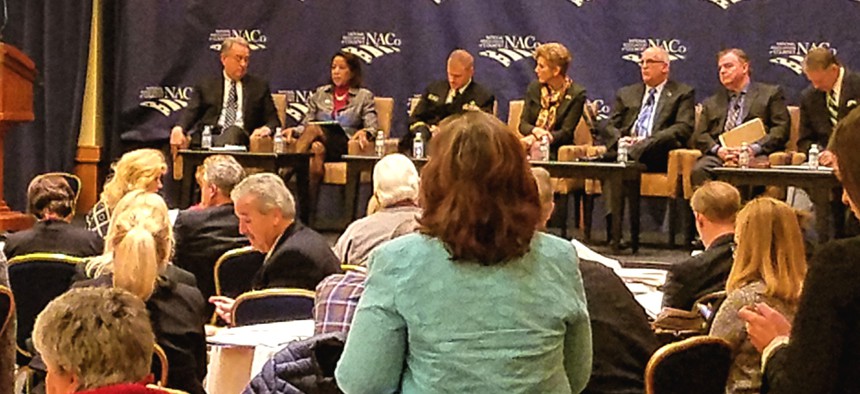For Many County Officials, the Opioid Epidemic Isn’t Political, It’s Personal

County government leaders from around the U.S. gather for a town hall meeting on the opioid abuse epidemic. Michael Grass / Route Fifty
At a National Association of Counties Legislative Conference town hall meeting, local officials shared powerful firsthand connections to the opioid epidemic.
When Kathy Dahlkemper, the county executive from Erie County, Pennsylvania, speaks with her fellow local officials about the opioid epidemic sweeping the nation, she consistently hears one claim.
Each of these local government workers thinks that his or her county, city, or town is the epicenter of the crisis.
These officials don’t have tunnel vision, and their hyper-local views don’t betray a lack of understanding of the scope of this problem. Instead, what this sentiment does reveal is a sad truth. In many places, few people remain who can truly claim to have no personal stake in this issue.
It’s a fact that is borne out by the data. In a poll conducted in 2016 by the Kaiser Family Foundation, 44 percent of those polled said they knew someone personally who has been addicted to prescription painkillers.
Those involved in local government are no different. So when the National Association of Counties convened a town hall meeting on the opioid epidemic on Sunday as part of the 2017 Legislative Conference in the nation’s capital they too brought deeply personal perspectives to bear.
The ‘Sordid History’ of Prescription Painkillers
The breadth of this personal experience runs the full continuum of this type of addiction—all the way from first prescription to fatal overdose. In the town hall audience, for example, several doctors and one nurse spoke to past training on painkiller prescribing practices.
One doctor in particular, Sharon Meieran, a county commissioner and an emergency room physician from Multnomah County, Oregon, told a story about what happened when she went through the process to get licensed to practice in the state.
At the time—this was 10 years ago—she was mandated to take a six hour-long course on pain management. In that course, she was taught that “basically pain can be treated by opioids, pain should be treated by opioids, there is no risk of addiction, and you can give as many [pills] as a patient wants to address what they believe their pain to be.”
Now, a decade later it isn’t hard for Dr. Meieran to place this type of instruction in the context of what she calls the “sordid history” of why these medications came to be prescribed so enthusiastically.
As Close to Death as Possible
The result of that sordid history is all too familiar to Phyllis Randall, the board of supervisors chair for Loudoun County, Virginia. By profession, Randall is a mental health therapist who specializes in serving offenders with substance abuse disorders in an adult detention center.
Having seen opioid addiction up close, she says this disease is unique in one particularly surprising way. In the past, she says, with any other substance if someone gets a “garbage batch” and someone dies from bad PCP, the rest of the PCP users in that area will avoid that batch, will avoid that dealer. Not so for heroin or fentanyl.
“If someone dies from opioids, every opioid user from 50 miles around will find out who sold the opioids that killed them, and that’s where they’re going to go.”
She asked her clients why that was and their answer always is “you want to get the dope that gets you as close to death as possible.”
‘Embarrassment … Is a 15 Year Old With a Needle in Her Arm’
On that tragic end of the spectrum is Dr. Richard Jorgensen, a trauma surgeon by training who spent most of his career in active practice, and now serves as the coroner for DuPage County, Illinois.
Jorgensen became the county coroner in 2012, and at that point, as he says he was “shocked by the young deaths” associated with drug overdose. He recalls one grim month in particular.
“In July of 2013 we had 18 overdoses in one month,” he said. “We had a person come in every single day after July 4.” At that time, there was such an enormous stigma associated with these deaths, Jorgensen said, nobody wanted to talk about them. In fact, he was even told that it would embarrass the county to acknowledge this issue.
His response? “An embarrassment to the county is a 15 year old with a needle in her arm, dead.”
The experience of dealing with those deaths shocked Jorgensen, and it shocked others in the county government to the point of action.
Later in the town hall, an even more visceral connection to the crisis surfaced. Bill Holen, a commissioner from Arapahoe County, Colorado, stood to offer a personal story and a question to the panel. Holen said that five years ago, his nephew “graduated from the University of Oregon with a business degree and an OxyContin habit.” Holen’s nephew is now dead.
His nephew’s passing prompted Holen to set up an opioid task force in his county and work to get legislation passed in the state assembly to enhance the prescription drug monitoring program and to increase naloxone access to first responders.
After offering his story, Holen then asked the members of the panel what roadblocks they had faced when trying to get opioid-related initiatives off the ground.
Politics Can Still Get in the Way
One answer to Holen’s question in particular proved that while personal connections to this epidemic have convinced many policy-makers to take bold actions, at times it still isn’t enough to overcome political differences that can thwart these controversial strategies.
Take Judge Executive Gary Moore’s story of his work to bring a syringe exchange to Boone County as an example.
The rate of Hepatitis C in Boone County, Kentucky, is 20 times the national average. The sharing of needles is highly prevalent in the county, and in the wider region. But, it is also a region that is deeply conservative.
A stipulation put in place by the state legislature requires that two out of the three counties in the region must agree upon the needle exchange before one may open. One of the neighboring counties has voted in favor of the needle exchange, but Judge Moore’s county, and its neighbor to the east are still unable to get the necessary votes. It’s an episode that Judge Moore reflects on as a failure.
Tragically, it make take more lives being affected by this crisis for political divisions like the ones hampering efforts in northern Kentucky to fall away.
Quinn Libson is a Staff Correspondent for Government Executive’s Route Fifty and is based in Washington, D.C.
NEXT STORY: Governors Assert Their Role in Federal Health Care, Infrastructure Conversations






